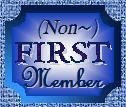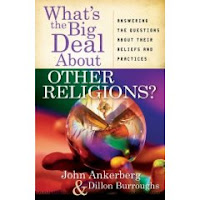
It’s July 15th, time for the Non~FIRST blog tour!(Join our alliance! Click the button!) Every 15th, we will featuring an author and his/her latest non~fiction book’s FIRST chapter!
The feature authors are:
John Ankerberg
and
Dillon Burroughs
and their book:
What’s the Big Deal About Other Religions
Harvest House Publishers (March 1, 2008)
ABOUT THE AUTHORS:
 Dr. John F. Ankerberg is the President and founder of The Ankerberg Theological Research Institute. He is also the producer and host of the nationally televised John Ankerberg Show, a half-hour program seen in all 50 states via independent stations, the DAYSTAR Network, the DISH Network, DirecTV and on the SKY ANGEL Satellite, numerous cable outlets, as well as on the internet. The program can be seen each week by a potential viewing audience in excess of 99 million people. John presents contemporary spiritual issues and defends biblical/Christian answers.
Dr. John F. Ankerberg is the President and founder of The Ankerberg Theological Research Institute. He is also the producer and host of the nationally televised John Ankerberg Show, a half-hour program seen in all 50 states via independent stations, the DAYSTAR Network, the DISH Network, DirecTV and on the SKY ANGEL Satellite, numerous cable outlets, as well as on the internet. The program can be seen each week by a potential viewing audience in excess of 99 million people. John presents contemporary spiritual issues and defends biblical/Christian answers.
 Writer and communicator Dillon Burroughs is author of fourteen books and serves as a staff writer and research associate for the Ankerberg Theological Research Institute. In the past two years, his books have sold over 113,000 copies while his edited works have sold more than two million copies. On subjects related to spirituality and culture, Dillon’s written projects have appeared in The New York Times, The Washington Post, Salem Radio Network news, Moody Radio Network, James Dobson’s Focus on the Family, iLife Television Network, Prime Time America, Leadership Journal, NBC affiliates, The John Ankerberg Show, Discipleship Journal, Group Magazine, and many other media outlets.
Writer and communicator Dillon Burroughs is author of fourteen books and serves as a staff writer and research associate for the Ankerberg Theological Research Institute. In the past two years, his books have sold over 113,000 copies while his edited works have sold more than two million copies. On subjects related to spirituality and culture, Dillon’s written projects have appeared in The New York Times, The Washington Post, Salem Radio Network news, Moody Radio Network, James Dobson’s Focus on the Family, iLife Television Network, Prime Time America, Leadership Journal, NBC affiliates, The John Ankerberg Show, Discipleship Journal, Group Magazine, and many other media outlets.
Dillon Burroughs is a ThM graduate from Dallas Theological Seminary in addition to graduating with a B.S. degree in Communications from Indiana State University. As time allows, he also serves as an adjunct professor at Tennessee Temple University. Dillon lives in Tennessee with his wife, Deborah, and two children, Ben and Natalie.
Product Details:
List Price: $12.99
Paperback: 256 pages
Publisher: Harvest House Publishers (March 1, 2008)
Language: English
ISBN-10: 0736921222
ISBN-13: 978-0736921220
AND NOW…THE FIRST CHAPTER:

Christianity:
What’s the Big Deal About Jesus?
“Christianity is good for you, but it’s not right for me. I think you ought to believe whatever makes you happy and gives you peace.”
“Christianity is the ‘right’ religion—isn’t that being naive?”
The label Christianity covers a broad range of people today. While over 2.1 billion people are statistically considered followers of Jesus Christ, polls by religious researcher George Barna have observed that only four percent of American Christians hold to a biblical worldview (that is, beliefs consistent with the Bible’s teachings), and just 51 percent of Christian clergy hold to such a view. As a result, even many who call themselves Christians have agreed with the quotes that appear above, asking if it is perhaps naïve to claim Christianity is the only way to God.
However, the above quotes are inconsistent with Christianity’s origins and founder. In this chapter we’ll briefly review how Christianity began, consider its early beliefs, introduce its founder, and investigate the reliability of the New Testament, which is part of the Bible.
A Firm Foundation
All of Christianity is built around one basic belief: the resurrection of its founder, Jesus of Nazareth. On Passover Friday around A.D. 30, Jesus was executed on a Roman cross on the accusation of conspiracy against the government. The Sanhedrin (Jewish leaders) had insisted that the Roman leader Pilate condemn Jesus, though Pilate had not found him guilty of any crimes worthy of death. After the crucifixion, death, and burial of Jesus in a tomb, the body disappeared three days later. Immediately this was followed by many “Jesus sightings” reported over the next 40 days. A social revolution began ten days later in Jerusalem, Israel, as over 3000 people joined the movement after a street message given by the apostle Peter (Acts 2). Christianity was off and running, and has been growing ever since.
Oxford University theologian Dr. Alister McGrath has noted,
The identity of Christianity is inextricably linked with the uniqueness of Christ, which is in turn grounded in the Resurrection and Incarnation.
How do we know Jesus came back to life? First, the 27 books of the New Testament are based upon this one event—the resurrection of Jesus. Despite the attacks of many, the writings of Christianity have been shown to have emerged during the first century with the courageous message that Jesus, a man executed by the government, was alive. This carried many implications about his life and death and beyond. What other motive did these writers have except that they truly believed all this had occurred?
In addition, many individuals of that day claimed to have encountered Jesus after his death. According to the Gospel writers and the missionary Paul, Jesus appeared a total of at least 12 times after his return from death:
The Post-Resurrection Appearances of Jesus Christ
# Sighting Source
1. Mary Magdalene–Mark 16:9; John 20:11-18
2. Women returning from the tomb–Matthew 28:9-10
3. Two men walking to Emmaus–Mark 16:12-13; Luke 24:13-32
4. Peter–Luke 24:34; 1 Corinthians 15:5
5. 10 disciples; two men from Emmaus–Luke 24:36-43; John 20:19-23
6. 11 disciples (including Thomas)–John 20:24-29
7. 7 disciples–John 21:1-24
8. 500 people at one time–1 Corinthians 15:6
9. James, the half-brother of Jesus–1 Corinthians 15:7
10. 11 disciples Matthew 28:16-20
11. 11 disciples before Jesus returned to heaven–Luke 24:50-53
12. Paul– Acts 9:3-6; 1 Corinthians 15:8
In just one of these sightings, over 500 people claimed to see Jesus alive after his death. Did you know that if each of those 500 people were to testify in court for only six minutes, including time for cross-examination, we would have an amazing 50 hours of firsthand testimony? Few other events from over 2000 years ago find this level of support. None offer the number of witnesses the resurrection does for a supernatural event.
Further, the changed lives of the early followers of Jesus supported their report that Jesus was alive. All but one of Jesus’ 11 followers died for his belief in the resurrection of Jesus. Hundreds—if not thousands—of other Christians suffered or died within the first century of Christianity for their beliefs as well. The killing of the first Christian martyr, Stephen, led to the persecution of the Jerusalem church, which eventually forced many Christians to flee the area for safety.
“Could you convince thousands of people in our own day that President Kennedy had resurrected from the dead? There’s no way…unless it really happened.”
The amazing phenomenon of Christianity’s growth also stands as a powerful testimony that this faith is based on a supernatural resurrection. How could a crucified Jew (Jesus), former tax collector (Matthew), Jesus-hater (Paul), and small town fishermen (including Peter) establish a movement that has resulted in the largest religion on Earth? How could this happen?
When Christianity began, the Roman Empire was the greatest government of the time. Yet 300 years later, the Roman Empire had crumbled, and Christianity was continuing to grow. This, in spite of its humble beginning as a grassroots network of individuals who witnessed that Jesus had come back to life. Even though the proclamation of Jesus’ teachings produced persecution of the greatest kind, Christianity continued to spread across the Roman Empire—all the way to the palace of Caesar in Rome, the world’s political and social capital.
Christianity 101
So Christianity originated from a group of Jesus-followers who spread the message that they had personally witnessed his three years of teaching and miracles, watched him die on a cross, and then personally met, saw, talked to, ate with, and received instructions from him after his resurrection from the dead. But what are the core beliefs of Christianity? There are six central elements of
traditional Christianity.
First, there is the common understanding of Jews and Christians that there is only one true God—who is infi nite, holy, loving, just, and true. In addition, Christians believe that in the nature (presence) of the one true God there exists three persons—Father, Son, and Holy Spirit. Christianity does not believe in three gods, but one. As Dr. Norman Geisler, bestselling author and cofounder of Southern Evangelical Seminary, has written,
The Trinity is not the belief that God is three personas and only one person at the same time and in the same sense. That would be a contradiction. Rather, it is the belief that there are three persons in one nature. This may be a mystery, but it is not a contradiction. That is, it may go beyond reason’s ability to comprehend completely, but it does not go against reason’s ability to apprehend consistently.
Further, the Trinity is not the belief that there are three natures in one nature or three essences in one essence. That would be a contradiction. Rather, Christians affirm that there are three persons in one essence…He is one in the sense of his essence but many in the sense of his persons. So there is no violation of the law of noncontradiction in the doctrine of the Trinity.
Traditional Christianity also accepts the 66 books of the Holy Bible as revelation from God, perfect and authoritative for all spiritual matters. While Roman Catholicism accepts the additional authority of the pope and church tradition, and Eastern Orthodoxy accepts church tradition as equal in authority to the Bible, the earliest traditional Christianity and later Protestant Christianity have been based solely on God’s written revelation through his apostles and prophets.
Third, Christians believe every person who has ever lived (with the exception of Jesus Christ) has been born a sinner separated from God. It is our sin nature that keeps us from knowing and experiencing God and creates a need for reconciliation through a means only God can provide.
Fourth, in his infinite love, God has provided the solution to the barrier between himself and humanity through Jesus Christ. The Bible teaches that the death of Jesus provides payment for our sins, and on the basis of our believing, he is our sinbearer and he will forgive us the moment we believe. All this is confirmed by Jesus’ resurrection from the dead—he has paid the penalty for sin and conquered death. In this way God offers a basis for a person to place his or her faith in Christ and to enter into a personal relationship with Jesus, in which he enters your life and you walk through life with his power and guidance.
Fifth, this rescue or salvation God offers through Jesus is based solely on what God has done rather than on what people do. In other words, salvation is a free gift based on God’s grace to us (unearned favor) rather than good works or deeds we can accomplish, though these will accompany a person once he or she becomes a Christian. One of the major points of contention during the Protestant Reformation resulted from the Roman Catholic Church’s unbiblical teaching
that God’s grace consists of humans cooperating with God’s grace to merit salvation, rather than receiving salvation in full as a gift on the basis of faith alone the moment a person believes.
Sixth, Christians believe in an eternal afterlife. God allows individuals the ability to choose or reject him, and after death, that decision is final. Those who have chosen to believe in Jesus will enjoy eternity with him in heaven, while those who decline will spend eternity in hell, separated from God. God will accept every person’s decision and not force him or her to change their mind. While all this may sound politically incorrect in our culture, it has stood as an essential component of Christian teaching from the earliest times. The choice we make here on earth will have eternal consequences.
Jesus: Founder and CEO of Christianity
Christian philosopher Dr. C. Stephen Evans points out that “it is an essential part of Christian faith that Jesus is God in a unique and exclusive way. It follows from this that all religions [that disagree] cannot be equally true.”7 Again, if different religions teach contradictory things about who God is, salvation, the afterlife, and
even Jesus, then one or another could be true, but they can’t all be true at the same time. What are the big super-signs that help us decide which religion is true? According to biblical Christianity, if Jesus claimed to be God and proved his claim by his resurrection, then he is God and Christianity is true. No other religious leader in history has claimed to be God and risen from the dead.
Further, there are at least seven concepts Jesus taught about himself that stand unique to Christianity. First, Jesus communicated that he fulfi lled biblical prophecy, given hundreds of years in advance, that he was the promised Messiah. He repeatedly claimed to be the person that God’s Messiah was predicted to be, and many scholars have created extensive lists of these prophetic connections. Here are some examples of prophecies Jesus fulfilled:
Prophecy–Old Testament Prophecy–New Testament Fulfillment
Born of a virgin– Isaiah 7:14– Matthew 1:18,25
Born in Bethlehem– Micah 5:2– Matthew 2:1
Preceded by a messenger– Isaiah 40:3– Matthew 3:1-2
Rejected by his own people– Isaiah 53:3– John 7:5; 7:48
Betrayed by a close friend– Isaiah 41:9– John 13:26-30
His side pierced– Zechariah 12:10– John 19:34
His death by crucifixion– Psalm 22:1,11-18– Luke 23:33; John 19:23-24
His resurrection– Psalm 16:10– Acts 13:34-37
Second, Jesus stands as a unique, unparalleled individual among the leaders of various world religions. He made predictions about the future that could only be made by someone who claimed to be God. Further, he noted in advance several of the things that would occur at the time of his death and resurrection. Unlike anyone else, he also promised to one day return to earth to set up his future kingdom.
The Seven “I Ams” of Jesus in John’s Gospel
* “I am the bread of life” (John 6:35,48; see also verse 51).
* “I am the light of the world” (John 8:12).
* “I am the gate for the sheep” (John 10:7; see also verse 9).
* “I am the good shepherd” (John 10:11,14).
* “I am the resurrection and the life” (John 11:25).
*“I am the way and the truth and the life” (John 14:6).
* “I am the true vine” (John 15:1; see also verse 5).
Further, Jesus is unique in his nature, being fully divine and fully human nature in one person. Jesus was born as a man without sin through a miraculous virgin birth. He challenged his own family, disciples, and even his enemies to prove him guilty of sin, but none could do so. Think of the reaction you would receive if you asked your parents, brothers, sisters, and friends, “Can any of you point to one sin I have committed?” Those closest to us know our faults. We all have them. Yet Jesus lived a perfect life free of sin.
As God’s divine son, Jesus performed miracles, healings, and exorcisms; fulfi lled Jewish prophecies; and accomplished his own resurrection. In these ways he affi rmed his divine nature, displaying power far beyond that of any person who has ever lived. Today people downplay the miracles, but they are documented in careful detail in the Bible, and even Jesus’ enemies did not deny his miracles. They weren’t able to. So they just claimed that he performed them with
the help of evil powers (Matthew 12:24).
The Exorcisms of Jesus
Exorcism– Source
1. Healed a demon-possessed man at Capernaum —Mark 1:21-28; Luke 4:31-37
2. Drove out demons and evil spirits Matthew 8:16-17; Mark 1:32-39; Luke 4:33-41
3. Healed the man possessed by demons at the Gadarenes– Matthew 8:28-34; Mark 5:1-20; Luke 8:26-39
4. Drove a demon out of a mute man, who then spoke– Matthew 9:32-34;
Mark 3:20-22
Christianity is also the only major religion whose founder sacrificed his life for the sins of those who would choose to believe in him. Jesus’ horrifi c death on the cross stood as proof of his statement that “the Son of Man [Jesus] did not come to be served, but to serve, and to give his life as a ransom for many.”
The Nature Miracles of Jesus
The Miracle—Source
1. Calming the wind and waves– Matthew 8:26; Mark 4:39; Luke 8:24
2. Walking on water– Matthew 14:25; Mark 6:48; John 6:19
3. Money in the fish’s mouth– Matthew 17:27
4. Withering of the fig tree– Matthew 21:19; Mark 11:14
5. Miraculous catch of fish– Luke 5:4-7
6. Turning water into wine– John 2:7-8
7. Second miraculous catch of fish– John 21:6
8. Feeding the 4000– Matthew 15:32-38; Mark 8:1-9
9. Feeding the 5000– Matthew 14:13-21; Mark 6:34-44; Luke 9:12-17; John 6:5-12
Sixth, as mentioned earlier, Jesus also rose from the dead. Those in his time could never account for his empty tomb and the disappearance of his body. Jesus’ followers spanned the known world testifying of his resurrection (his actual bodily appearing to them), teaching his words, and dying for their belief in him.
Finally, Jesus promises, at the end of time, to personally judge every person who ever lived. It would be eternally disappointing to have Jesus look at us, fairly judge us, and conclude, “I never knew you” (Matthew 7:23).
Christianity by the Book
Those who want to investigate the truthfulness of the original Christian message can look to a wealth of manuscript evidence regarding the transmission of the 27 books of the New Testament through the years. The New Testament manuscripts offer more supporting evidence than any other ancient book. Christians also accept the Jewish scriptures (the Old Testament) as part of their holy book, the Bible. Traditional Christianity believes in the inerrancy of Scripture, meaning the original words of the Bible’s books are without error and perfect in every way.
As a result, Bible translation, distribution, and teaching stand as important responsibilities within Christianity. The Bible is the most translated book in history, has been used as the script for the most-watched fi lm in history (the Jesus fi lm), and has enjoyed greater distribution than any book in the world. Over 100 million copies of the New Testament or Bible are sold every year worldwide.
Interesting Statistics About the Bible
The Bible was written over a period of 1600 years,
* by more than 40 authors of every sort—kings, peasants, fi shermen, poets, shepherds, government offi cials, teachers, and prophets—
* in three languages (Hebrew, Aramaic, and Greek),
* on three continents—Asia, Africa, and Europe.11
What Makes Christianity Unique?
“Christianity isn’t about people in search of God, but rather God in search of
people.”—STEVE RUSSO
Many have suggested that Christianity is about having a personal relationship with Jesus, and not performing good works and following rituals. Religious movements throughout history ultimately hold to a signifi cantly different common thread—that certain actions or works are required to obtain a blissful afterlife. In Christianity, however, the key to reaching God here and now and dwelling with him for eternity is to receive and trust in a gift already provided by its founder, Jesus Christ. As the apostle Paul made clear to Christians at Ephesus, “God saved you by his grace when you believed. And you can’t take credit for this; it is a gift from God. Salvation is not a reward for the good things we have done, so none of us can boast about it.”
God’s gift of salvation also brings assurance. If Jesus’ righteous life and atoning death on the cross is the sole basis for God’s gift, then a Christian doesn’t have to worry about earning or losing that gift. Once the gift is received, it belongs to the Christian forever because it rests on what Jesus did—not what the Christian did or does in the past, present, or future.
Christianity in Summary
As we compare and contrast the beliefs of various religions throughout this book, we hope to make the distinctives of each one as clear as possible. Here, we summarize the key teachings of Christianity:
Belief– Basic Description
God– One God in three persons—Father, Son, and Holy Spirit.
Holy Book– The 66 books of the Holy Bible are the authoritative
works of Christianity.
Sin– All people have sinned (except Jesus).
Jesus Christ– God’s perfect son, holy, resurrected, divine (second person of the Trinity) yet also fully human.
Salvation– Obtained only by God’s grace through faith in Jesus Christ, not by human effort.
Afterlife– All people will enter heaven or hell upon death based on whether they have salvation in Jesus Christ. The Bible does not teach reincarnation, annihilation (ending of the soul), or the existence of purgatory.
Some people assume that biblical Christianity and Roman Catholicism are essentially similar. But is that the case? What differences exist? Are these differences really a big deal, or only minor details? Our next chapter will address these questions head-on.





